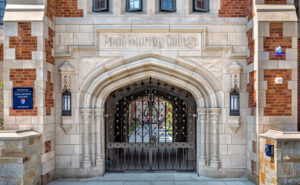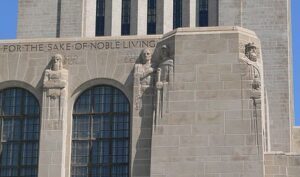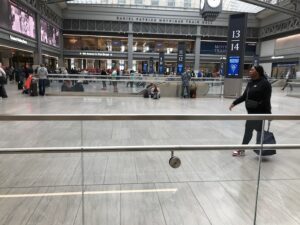Witold Rybczynski's Blog, page 8
August 26, 2022
CAREERS
Moshe Safdie has just donated his architectural archive of correspondence, drawings, and models, as well as his apartment in Habitat, to his alma mater, McGill University. His is a remarkable career, not least for its long span. Of course Safdie started young, he was only 29 when Habitat—his first project!—propelled him into the limelight. Most architects who experience a break-out project do so at a relatively advanced age—Louis Kahn was 52 when he came to the public’s attention, Frank Gehry was 49. Edwin Lutyens, an exception like Safdie, skipped school and designed his first house at 18, and was nationally known by the time he reached his mid-30s (he died at 74). The one architect I can think of who bears direct comparison with Safdie is Frank Lloyd Wright, whose Prairie Houses date from his 30s, and whose career likewise exceeded 50 years. Of course, he lived to be 91; Safdie is 84 and going strong. Sto lat, Moshe, sto lat.
The post CAREERS first appeared on Witold Rybczynski.
July 18, 2022
REVIVALS VS. TRANSPLANTS

Pauli Murray College, Yale
Revivalism in architecture refers to a style that consciously echoes or evokes the style of a previous era. This blurs an important distinction. The Italian Renaissance and the British Gothic Revival were echoing the styles of earlier local eras. The Greek Revival, on the other hand, whether it occurred in Berlin, Edinburgh, or Philadelphia, was a foreign style from far away; it was a transplant. That does not mean that the former was more authentic, but it does give it a different meaning. When James Gamble Rogers was designing the Yale colleges in the early twentieth century he was not reviving a tradition; he had a collection of postcards and photographs of Oxbridge colleges that served as his inspiration. On the other hand, Franklin and Murray colleges, completed by Robert A. M. Stern in 2017, are a revival of Rogers’s Collegiate Gothic. Not the same thing.
The post REVIVALS VS. TRANSPLANTS first appeared on WITOLD RYBCZYNSKI.
July 2, 2022
WEIRDOS
 A “nation of weirdos” is how Michael Brendan Doherty characterized the United States the other day on The Editors Fourth of July podcast. It was meant kindly. The weirdos have included Thomas Edison, Henry Ford, and Steve Jobs, as well as the inventors of the hula hoop, the smoothie, and the pet rock. The pursuit of happiness takes many unexpected twists and turns.
A “nation of weirdos” is how Michael Brendan Doherty characterized the United States the other day on The Editors Fourth of July podcast. It was meant kindly. The weirdos have included Thomas Edison, Henry Ford, and Steve Jobs, as well as the inventors of the hula hoop, the smoothie, and the pet rock. The pursuit of happiness takes many unexpected twists and turns.
The post WEIRDOS first appeared on WITOLD RYBCZYNSKI.
June 18, 2022
DECADENCE

Nebraska State Capitol, Bertram Goodhue, architect & Lee Lawrie, sculptor, 1932
I was listening to some old interviews on Tyler Cowen’s podcast, Conversations with Tyler, and came across this one, with Ross Douthat, made in March, 2020. Douthat made this observation about architecture: “I would say that, basically, the place that modern architecture has ended up and the traditionalist alternative are both sort of decadent . . .” I found that interesting, since modernism and traditionalism are usually described as a divide rather than as evidence of the same thing. Decadence in modernism is apparent in the (fruitless) search for unceasing novelty, that takes architects into increasingly obscure ratholes. In traditionalism decadence can be the result of a sometimes fawning admiration for the past, that inhibits the sort of originality that—in different ways—fueled the architecture of Michelangelo and Borromini, or more recently of Bertram Goodhue.
The post DECADENCE first appeared on WITOLD RYBCZYNSKI.
May 15, 2022
HIS MASTER’S VOICE
 An odd thing happened to me the other day. I was talking to someone and I used an expression that I had never used before, but was something that Shirley might have a said. Even as I spoke I recognized her voice and for a weird split-second I felt like a ventriloquist’s dummy. Not necessarily a bad thing, I thought to myself.
An odd thing happened to me the other day. I was talking to someone and I used an expression that I had never used before, but was something that Shirley might have a said. Even as I spoke I recognized her voice and for a weird split-second I felt like a ventriloquist’s dummy. Not necessarily a bad thing, I thought to myself.
The post HIS MASTER’S VOICE first appeared on WITOLD RYBCZYNSKI.
April 30, 2022
MOYNIHAN HALL, CONT’D.
 A little more about the question of style. Style is not about what you say but how you say it, not about content but delivery. The impersonal announcements of voicemail, or of a public address system, are almost pure content, there is very little delivery beyond a certain functional brevity. But an actual person speaking includes variable emphasis of tone and volume, facial expressions, hand gestures, asides, jokes, and so on. The effect can be conversational or stentorian, formal or informal, intimate or cold, depending on the style. That is why the word was originally used in the context of rhetoric. Architectural style is comparable. Pennoyer’s clock in Moynihan Hall is sometimes described as Art Deco, which I suppose it suggests, although the clock face is as modern as a Max Bill timepiece. Art Deco has a frivolous side, but this clock is monochrome matte grey, so rather serious, although the telescoping form is sculptural, so it’s not completely serious. “You need to know the time but there is more to life than train schedules.” The decoration is restrained, but it’s there, which gives us something to look at. That is what is missing in the architecture of the hall—there is nothing to look at. This is not really SOM’s fault, or at least it’s not because they made mistakes. Once committed to a modern architectural vocabulary, the result was preordained. Modernist architects eschew style, or rather, they work in only one style, which can be characterized as “functional,” “clean,” or “no-nonsense.” Just the facts, ma’am. But the hall of an important railroad station in an important city demands more than facts. That is what the architects who designed the great stations of the Moderne era—Thirtieth Street in Philadelphia, Union Station in Omaha, Union Terminal in Cincinnati, understood.
A little more about the question of style. Style is not about what you say but how you say it, not about content but delivery. The impersonal announcements of voicemail, or of a public address system, are almost pure content, there is very little delivery beyond a certain functional brevity. But an actual person speaking includes variable emphasis of tone and volume, facial expressions, hand gestures, asides, jokes, and so on. The effect can be conversational or stentorian, formal or informal, intimate or cold, depending on the style. That is why the word was originally used in the context of rhetoric. Architectural style is comparable. Pennoyer’s clock in Moynihan Hall is sometimes described as Art Deco, which I suppose it suggests, although the clock face is as modern as a Max Bill timepiece. Art Deco has a frivolous side, but this clock is monochrome matte grey, so rather serious, although the telescoping form is sculptural, so it’s not completely serious. “You need to know the time but there is more to life than train schedules.” The decoration is restrained, but it’s there, which gives us something to look at. That is what is missing in the architecture of the hall—there is nothing to look at. This is not really SOM’s fault, or at least it’s not because they made mistakes. Once committed to a modern architectural vocabulary, the result was preordained. Modernist architects eschew style, or rather, they work in only one style, which can be characterized as “functional,” “clean,” or “no-nonsense.” Just the facts, ma’am. But the hall of an important railroad station in an important city demands more than facts. That is what the architects who designed the great stations of the Moderne era—Thirtieth Street in Philadelphia, Union Station in Omaha, Union Terminal in Cincinnati, understood.
The post MOYNIHAN HALL, CONT’D. first appeared on WITOLD RYBCZYNSKI.
April 29, 2022
MOYNIHAN HALL
 When I was a practicing architect and a structural problem arose I would ask my engineer friend, Emmanuel Leon, for advice. Once I was designing a house which required a long span. In his pragmatic Filipino way he asked me, “Do you want it cheap or architectural?” (I wanted the latter and he designed an upside-down king post truss.) I thought of Emmanuel when I walked into Penn Station in New York recently. It was my first trip on Amtrak in several years, and I was looking forward to seeing the much lauded station hall, which is in the old Farley post office building. I was disappointed. For one thing, the space was small. My train had left Philadelphia’s Thirtieth Street Station (designed by Graham, Anderson, Probst & White in 1927-33), which has a majestic hall, and this space was puny by comparison. And the steel trusses overhead were definitely utilitarian rather than architectural (they had originally spanned the mailroom). I had read plaudits about the suspended clock in the center of the hall, designed by Peter Pennoyer. It is very handsome, and it highlights one of the main drawbacks of its surroundings; unlike the clock, or Thirtieth Street Station, for that matter, the new station has no sense of style. The generic architecture (designed by SOM) could be an office building lobby or a shopping mall just about anywhere. And unlike Thirtieth Street, which has long oak benches, there is nowhere to sit except a claustrophobic “waiting room.” So passengers sprawl on the floor. Not attractive. Did I mention that it’s called Moynihan Hall, after the great senator? The name is displayed everywhere, over and over again, as if that would make up for the pedestrian design. Moynihan, who had an eye for architecture, would wince.
When I was a practicing architect and a structural problem arose I would ask my engineer friend, Emmanuel Leon, for advice. Once I was designing a house which required a long span. In his pragmatic Filipino way he asked me, “Do you want it cheap or architectural?” (I wanted the latter and he designed an upside-down king post truss.) I thought of Emmanuel when I walked into Penn Station in New York recently. It was my first trip on Amtrak in several years, and I was looking forward to seeing the much lauded station hall, which is in the old Farley post office building. I was disappointed. For one thing, the space was small. My train had left Philadelphia’s Thirtieth Street Station (designed by Graham, Anderson, Probst & White in 1927-33), which has a majestic hall, and this space was puny by comparison. And the steel trusses overhead were definitely utilitarian rather than architectural (they had originally spanned the mailroom). I had read plaudits about the suspended clock in the center of the hall, designed by Peter Pennoyer. It is very handsome, and it highlights one of the main drawbacks of its surroundings; unlike the clock, or Thirtieth Street Station, for that matter, the new station has no sense of style. The generic architecture (designed by SOM) could be an office building lobby or a shopping mall just about anywhere. And unlike Thirtieth Street, which has long oak benches, there is nowhere to sit except a claustrophobic “waiting room.” So passengers sprawl on the floor. Not attractive. Did I mention that it’s called Moynihan Hall, after the great senator? The name is displayed everywhere, over and over again, as if that would make up for the pedestrian design. Moynihan, who had an eye for architecture, would wince.
The post MOYNIHAN HALL first appeared on WITOLD RYBCZYNSKI.
March 26, 2022
A VISIT
 Sometimes I imagine that Shirley comes home. At least to visit. She looks around our loft, in which little has changed in nine months. “That’s new,” she says, pointing to a framed photograph in the bookcase. It is of her, sitting at the table, in front of that same bookcase. I got it to balance the old photograph of her, taken in the sixties, before we met; glamorous with long hair and large sunglasses. “Why are all my glasses still here?” she asks pointing to a half dozen cases—Robert Marc, Iyoko-Inyaké, Ray-Ban. I sense disapproval in her voice. We go upstairs to the bedroom. She looks in the closet. “You’ve kept my Zuri dresses and Trippen shoes,” she says. “And all my beautiful coats. Why? Shouldn’t you get rid of them?” I am abashed, but I don’t know how to do that. “Maybe later,” I tell her.
Sometimes I imagine that Shirley comes home. At least to visit. She looks around our loft, in which little has changed in nine months. “That’s new,” she says, pointing to a framed photograph in the bookcase. It is of her, sitting at the table, in front of that same bookcase. I got it to balance the old photograph of her, taken in the sixties, before we met; glamorous with long hair and large sunglasses. “Why are all my glasses still here?” she asks pointing to a half dozen cases—Robert Marc, Iyoko-Inyaké, Ray-Ban. I sense disapproval in her voice. We go upstairs to the bedroom. She looks in the closet. “You’ve kept my Zuri dresses and Trippen shoes,” she says. “And all my beautiful coats. Why? Shouldn’t you get rid of them?” I am abashed, but I don’t know how to do that. “Maybe later,” I tell her.
The post A VISIT first appeared on WITOLD RYBCZYNSKI.
March 24, 2022
CHRISTOPHER ALEXANDER (1936-2022)
 When I was a student at McGill, my friend Ralph Bergman and I started a magazine, Asterisk, actually it was named *. The second issue, this was 1964, included an article by Alexander and the architect B.V. Doshi on designing a village in India. A couple of years later, when I was working on my thesis, another classmate, Richard Rabnett, had come across HIDECS, Alexander’s computer program for ordering criteria in architectural design. It was in FORTRAN, and we laboriously entered our information onto punch cards, although we never could get the program to run (years later I learned that HIDECS was flawed and could not actually run). My next encounter with Alexander was in 1978 in Mexico City. I had been invited to speak at a symposium at the Universidad Nacional—Alexander would deliver the keynote. Expecting the usual sparse turnout I was amazed to find an audience of several hundred excited students—not there for me, I hasten to add. The previous year, Alexander had published A Pattern Language, and it had turned him into an international star. I had a copy, of course. One of his principles was that design could not be disconnected from the actual process of construction. At the time, my wife and I were building our own house, an experience that validated—at least for me—the truth of this assertion: many of our most important design decisions were made on the building site not on paper. I followed Alexander’s career through his many books, which still remain a part of my reduced library. In 1994, I had an opportunity to meet the man when he was awarded the Seaside Prize. During a conversation he said something that has stuck with me: everything that we see in our surroundings—everything—either slightly raises our spirits or slightly lowers them. Our paths last crossed in 2009, when he was awarded the Vincent J. Scully Prize. Alexander, who was now living in England, was down with pneumonia and unable to attend, and I joined a panel of previous laureates to speak about the man and his work. In my remarks I compared Alexander to Jane Jacobs. “I think there’s a sense in which both of them see the world as very, very messy, and they see the charm in that. And they’re on the one hand looking for order, but also at the same time very worried that too much order will lose the thing that you actually value.” This creative tension is present both in the insightful books that he wrote and the beautiful buildings that he built.
When I was a student at McGill, my friend Ralph Bergman and I started a magazine, Asterisk, actually it was named *. The second issue, this was 1964, included an article by Alexander and the architect B.V. Doshi on designing a village in India. A couple of years later, when I was working on my thesis, another classmate, Richard Rabnett, had come across HIDECS, Alexander’s computer program for ordering criteria in architectural design. It was in FORTRAN, and we laboriously entered our information onto punch cards, although we never could get the program to run (years later I learned that HIDECS was flawed and could not actually run). My next encounter with Alexander was in 1978 in Mexico City. I had been invited to speak at a symposium at the Universidad Nacional—Alexander would deliver the keynote. Expecting the usual sparse turnout I was amazed to find an audience of several hundred excited students—not there for me, I hasten to add. The previous year, Alexander had published A Pattern Language, and it had turned him into an international star. I had a copy, of course. One of his principles was that design could not be disconnected from the actual process of construction. At the time, my wife and I were building our own house, an experience that validated—at least for me—the truth of this assertion: many of our most important design decisions were made on the building site not on paper. I followed Alexander’s career through his many books, which still remain a part of my reduced library. In 1994, I had an opportunity to meet the man when he was awarded the Seaside Prize. During a conversation he said something that has stuck with me: everything that we see in our surroundings—everything—either slightly raises our spirits or slightly lowers them. Our paths last crossed in 2009, when he was awarded the Vincent J. Scully Prize. Alexander, who was now living in England, was down with pneumonia and unable to attend, and I joined a panel of previous laureates to speak about the man and his work. In my remarks I compared Alexander to Jane Jacobs. “I think there’s a sense in which both of them see the world as very, very messy, and they see the charm in that. And they’re on the one hand looking for order, but also at the same time very worried that too much order will lose the thing that you actually value.” This creative tension is present both in the insightful books that he wrote and the beautiful buildings that he built.
The post CHRISTOPHER ALEXANDER (1936-2022) first appeared on WITOLD RYBCZYNSKI.
March 22, 2022
A HOLIDAY FROM HISTORY
 I was listening to a conversation between Peter Robinson and Bari Weiss on the Hoover Institution’s Uncommon Knowledge podcast. I was brought up short by Weiss’s phrase: “a holiday from history.” Weiss and Robinson were talking about what she called The Great Unraveling, but it struck me that a “holiday from history” could easily refer to architecture, which since roughly the 1920s has turned away from the past. Where once architects had learned their art in part by studying history, whether in books or through travel, they now had their vision resolutely focused in only one direction—the future. In that way, design was simplified. No need to take on Mr. Bramante or Mr. Wren (to use a Hemingwayesque locution)—you were free to make your own rules. This was at first exciting, and one sees this excitement in the early work of Corbusier and Mendelsohn. But succeeding generations have found the holiday from history could also be a bit of a bore, as well as a challenge—it is not so easy to continually reinvent an architecture “for our time.” All holidays come to an end, of course. Will architects return to a more tried and true method: looking back in order to move forward, in James Stirling’s words?
I was listening to a conversation between Peter Robinson and Bari Weiss on the Hoover Institution’s Uncommon Knowledge podcast. I was brought up short by Weiss’s phrase: “a holiday from history.” Weiss and Robinson were talking about what she called The Great Unraveling, but it struck me that a “holiday from history” could easily refer to architecture, which since roughly the 1920s has turned away from the past. Where once architects had learned their art in part by studying history, whether in books or through travel, they now had their vision resolutely focused in only one direction—the future. In that way, design was simplified. No need to take on Mr. Bramante or Mr. Wren (to use a Hemingwayesque locution)—you were free to make your own rules. This was at first exciting, and one sees this excitement in the early work of Corbusier and Mendelsohn. But succeeding generations have found the holiday from history could also be a bit of a bore, as well as a challenge—it is not so easy to continually reinvent an architecture “for our time.” All holidays come to an end, of course. Will architects return to a more tried and true method: looking back in order to move forward, in James Stirling’s words?
The post A HOLIDAY FROM HISTORY first appeared on WITOLD RYBCZYNSKI.
Witold Rybczynski's Blog
- Witold Rybczynski's profile
- 178 followers



